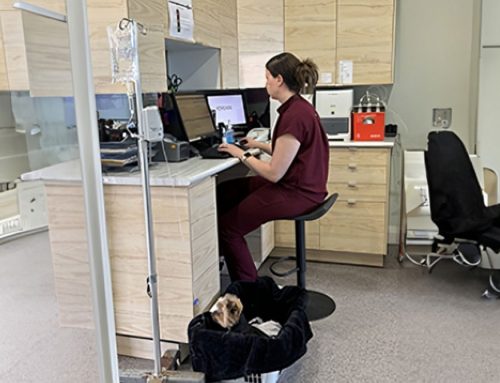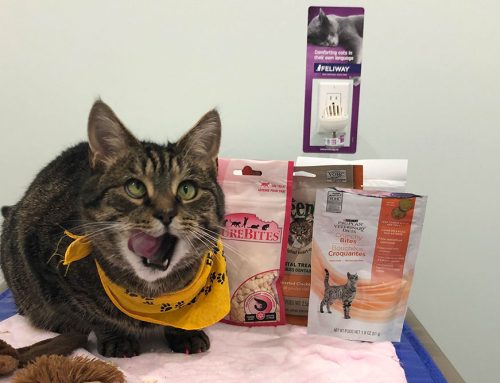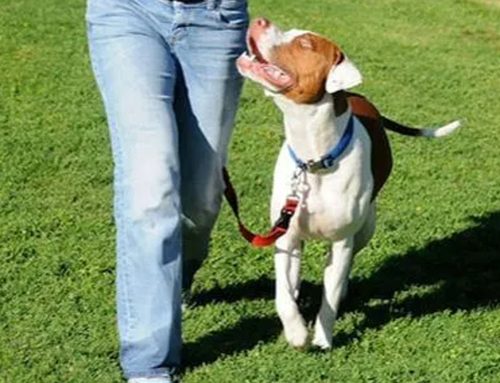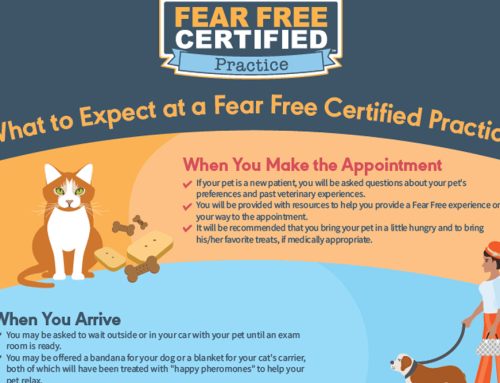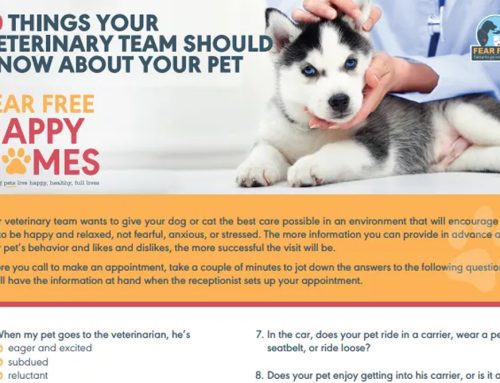CHANGE THE WAY YOUR PET VIEWS RESTRAINT AND HANDLING!
Do you have a pet that hates having their nails trimmed? Or maybe your pet is fine at the vet EXCEPT when it comes to taking their temperature. One way to deal with these fears is to utilize the concept of “desensitization” and “classical conditioning”.
Desensitization is the process of teaching the learner that a specific stimulus is non-threatening over time, through repeated controlled gentle exposures.
Classical conditioning links emotional responses with a stimulus over time through predictions.
The goal is to link stimuli such as having your pet’s tail lifted or having their nails trimmed, with a yummy treat to create a positive emotional response.
The basic routine is:
- Stimuli, starting at a level where your pet is comfortable (example lifting your pet’s paw, touching their face)
- Verbally mark the reward by saying “Treat”
- Present the reward within 2-3 seconds of saying “Treat”
- Gradually increase the stimuli, e.g go from picking up your pet’s paw, to touching the paw with the clippers, to eventually trimming your pet’s nails.
Key Tips:
Make sure your pet likes the treat you are offering and knows how to use the treat delivery method. For example, not all pets are used to eating off a spoon or tongue depressor.
Go slow – Listen to your pet and only increase the intensity when your pet is comfortable
These videos fast forward the training process for learning purposes.
Getting your pet used to having their teeth brushed!
Brushing your pet’s teeth daily is the best thing you can do at home to keep your pet’s teeth and gums healthy. Unfortunately, our pets haven’t had any lessons in oral hygiene so they may or may not be willing participants in the daily brushing session.
Start by touching your pet’s face and gradually work towards being able to lift their lip. Once your pet is comfortable with this, grab a tooth brush and eventually, you’ll be able to start brushing!
Please give Lette Broom a round of applaws!
During the warmer months your pet will need flea and tick medication.
Some of you may ask, how do I apply the medication on my cat? Or, how on earth am I going to get my dog to sit still? The answer? Handling sessions!
Start by getting your cat used to being gently restrained, gradually start to part the fur and hold the vial towards the coat. Soon this monthly task will be done in seconds!
Don’t forget, ticks can also attach to cats as well as dogs. Which means your cat that likes to wander in the backyard could very well pick up some passengers.
Please give Matilda Mac a round of applaws!
By popular demand, how to get your cat used to nail trims!
Desensitization and classical conditioning can help make kitty pedicures a much less …. dangerous experience. Our goal is to link stimuli (lifting the paw, playing with toes, trimming nails) with a yummy treat to create a positive emotional response.
Remember the paws are a very sensitive part of the body, so be mindful to move slowly when going through the different steps of trimming your pet’s nails.
For example, don’t start to pick up your pet’s paw, if they still aren’t used to be restrained. Similarly, don’t introduce the clippers, until your pet is comfortable having their toes played with.
Please give Matilda Mac a round of applaws!
How do you know if your pet is comfortable?
Signs of stress:
- Fidgeting
- Ears slightly back or to the side
- Panting
- Tight mouth
- Low tail position
- Starting to not accept treats.
If your cat starts to seem stressed, give them a break and try again later.
Please give Matilda Mac a round of applaws!
The same principles can be applied to getting your dog used to the nail dremel.
The biggest challenge with the dremel is the sound of the machine. Start with getting your dog used to having their feet handled. Then get your dog used to the sound of the dremel starting by starting the machine away from your pet and gradually moving it closer.
Please give Titan a round of applaws!
The ultimate kitty challenge … giving your cat tablets!
Inevitably, at some point in your cat’s life, you will need to give your cat medication. Sometimes we can hide the medication in food or pill pockets but cats are pretty smart.
Break this process down into small steps as the face and mouth is a very sensitive area of the cat’s body.
Start by showing your cat the treat delivery method, then get your cat used to restraint. Gradually move to handling their face and then finally opening the mouth.
Remember to closely monitor your cat for signs of stress. Only move to the next step once your cat is completely comfortable.
Investing the time into getting your cat used to the restraint required for pilling a cat will make the process significantly less stressful when your cat isn’t feeling well. It will also make you significantly more successful in convincing your cat this isn’t a horrible event, if you aren’t actually giving him/her a tablet during the training process.
Please give Matilda Mac a round of applaws!
Desensitization and counter conditioning can be very helpful in making daily care for your pets easier. For example, pets that need regular ear cleaning.
Working on these scenarios when your pet DOESN’T have a problem (when the ear is not painful) will make treating your pet when there is a problem much easier.
Start by getting your pet used to having the ear flap lifted, then gradually pick up the cleaning solution (or a prop bottle) and work towards applying the solution.
Please give Loki a round of applaws!
Have you ever wondered what you would do if you had to apply eye medication to your dog’s eye?
Most eye medications need to be applied at least twice a day, sometimes even five times a day. You can apply desensitization and counter conditioning to help make this process much more manageable and pleasant for both you and your pet.
Start by getting your pet used to having their face handled, gradually begin touching around their eyes (this is a sensitive part of the body), then begin pulling the eye lids back. Eventually start to hold a small bottle near by as if you were going to put a drop into the eye.
Remember, working on these scenarios when your pet DOESN’T have a problem (when the eye is not painful) will make treating your pet when there is a problem much easier.
Please give Loki a round of applaws!
Just like people, animals can be scared of needles too. For your pet, they know the signs of an injection, the veterinary clinic and most importantly, the pinching of the skin before the injection is given.
For very needly shy patients, the first signs of fear come from the moment we pinch the skin in preparation for the injection. They normally don’t even feel the actual injection itself!
You can help your pet by working on getting them used to restraint, the tenting of the skin and a poke with a blunt object. Making this process (up until the actual injection) a normal part of life can significantly help your pet during at their actual veterinary appointment.
This can be particularly helpful for patients that require injections as home, such as diabetics.
A special round of applaws for Matilda Mac!
Some pets are not used to be restrained. It is not common that we hear that pets “like to do things on their own terms”. However, restraint for procedures is an essential part of training. For example, all dogs need an annual heartworm test which requires restraint for a blood draw.
Remember, your pet will be more open to learning when they are not in a stressful environment, such as at home with their owner. Getting your pet used to being restrained at home in a familiar environment will help them be much more comfortable when they are being restrained at the veterinary clinic.
Please give Loki and Lette a round of applaws!
These small training sessions can go a long way at making your pet much more comfortable at the vet.
Remember to keep training sessions short and fun!
If you would like to start working with your pet at home or have any questions about how to apply these concepts please contact us at 905 208 9933 or reception@macvets.com. We would be more than happy to help you utilize these training methods.

